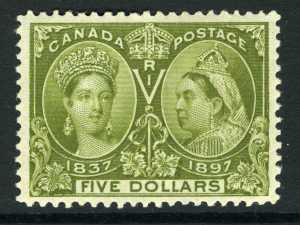Paper seems very much the same to non–collectors, and certainly, in the modern period, collectors have had to pay very little attention to issues caused by paper. The United States printed its first stamps on a very hard, thin paper and continued using harder, thinner paper until about 1890. After 1890, the American Bank Note Company (and then later the Bureau of Engraving and Printing) switched to a much thicker more porous paper. This paper took ink from the plates more readily and produced greater consistency of printing, but at the cost of making stamps more prone to thinning and creasing. That these papers were a choice not chance is proven by the fact that the American Bank Note Company produced US stamps in the 1890s and also produced Canadian stamps. Look at any auction catalog or on Ebay and see the comparative number of Canadian 1897 Jubilees with thins compared with the 1893 Columbians, both of which were produced by the same company with the same printers on the same presses. The 1893 Columbians are rarely found today without defect. The Canadian issue in nearly always found in better overall condition. And yet the paper that the stamps were printed on is virtually identical
George Sloane, whose book I have been rereading this week, makes a point in a 1956 article that pertains to this. “Why is it,” he asks, “that such a high percentage of Airmail invert stamps (#C3a) are damaged? Look in any auction catalog. Chances are two out of three that the Invert listed for sale will be listed with some kind of fault from crease to thin to even small tears. And regumming is common too. This was a stamp that was a rarity from its discovery in 1918. It was sold directly to dealers and collectors who knew from the start its rarity status. So why couldn’t these stamp’s owners take better care of them over the years?”
Or to draw the point more broadly and to show that it is peculiarly an American problem, look again at the 1893 Columbian issue. The dollar values of this set are nearly always defective. And yet why? Again, from the start they were sold almost exclusively into collector hands. And for those of you who want make the “soft paper” argument, that is, that US stamps from the early period were printed on soft paper which thinned and damaged easily, the 1898 Canadian Jubilees were printed on a similar paper to the US Columbians by the same printer, and yet it is unusual to find a damaged dollar value Jubilee. Or look at European stamps. Who ever saw a damaged Austrian Dolffus? Or GB Pound PUC?
Are Americans so much more careless that they unintentionally damage their property to a far greater degree than do collectors in other nations? The “velocity of turnover” argument might explain it. Perhaps Americans buy and sell their stamps more often than other collectors, and each time a stamp is sold it is handled numerous times creating a chance for it to be harmed. I don’t really know. Perhaps a reader has an idea.



